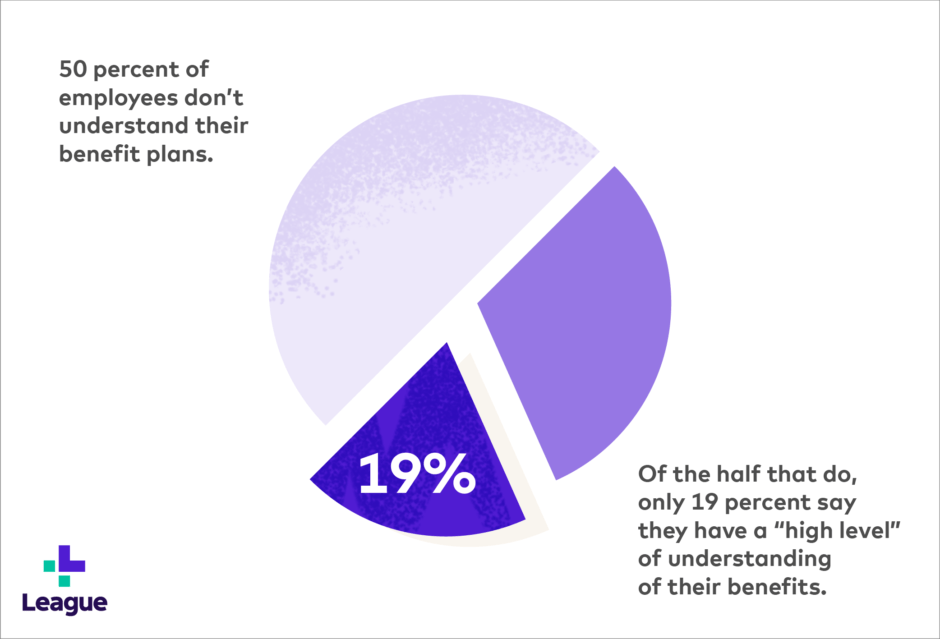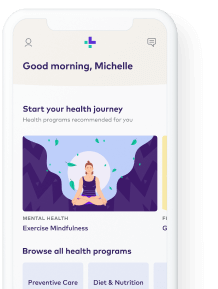It’s an HR team’s nightmare: You’ve made a substantial investment in best-of-breed point solutions, yet employees aren’t taking advantage of their benefits. Worse yet, health costs continue to rise (along with your administrative burden).
One thing is clear: the investment—in both time and money—you make to keep those benefits available is going to waste. A pulse survey by Harvard Business Review revealed that 58% of employees are unaware of their benefits entitlement, and 63% are unsure how to access them. This has a serious impact on your healthcare ROI.
Companies facing problems like these already realize it’s simply not enough to throw money at providing benefits. They need an entirely new strategy for deploying benefits—a better platform for driving benefit education and awareness, benefit engagement and benefit utilization. But what is it?
To address the problem of wasted costs and underutilization of benefits, we need to get to the root of why people don’t engage with their health benefits. Then we can explore how to get more employees to take advantage of them.
Why employees don’t use their benefits
The first step to achieving better employee engagement with benefits is understanding why people don’t take advantage of their workplace perks in the first place. These are some of the most common reasons employees don’t utilize their benefits.
Employees have a hard time navigating their benefits
Most benefits ecosystems are complex and difficult for employees to navigate. As specific healthcare needs arise and change, employers invest in more point solutions to address things, one by one. This makes the experience even more complex and fragmented for employees, making it more and more difficult for them to understand what’s available to them. If they aren’t aware of what they’ve got, they can’t utilize it.
Announcing these new benefits may not help—this communication usually comes at the same time as annual enrollment, and amid all that information, new benefits can easily get lost. It’s clear that simply adding new solutions and then telling people about them isn’t enough. We need to make it easier for employees to navigate them.
Half of employees don’t understand their benefits
Even when your employees do know about their benefits, they may not understand them. A study by the International Foundation of Employee Benefit Plans found around half of all employees don’t understand their benefit plans. And of the half who do understand their benefits, only 19 percent said they have a “high level” of understanding of what their benefits are, how they work and how to use them.
Not only do we need to make it easier for employees to navigate their benefits, we need to make it easier for them to understand them. Only then can employees start to better utilize them.

Employees don’t understand the full value of their benefits
We already know half of all employees don’t understand their benefits, but the data gets even more alarming—up to 80 percent of companies report their employees don’t open or read their benefits materials.
The point of employee benefits is all in the name: They’re supposed to benefit employees and their families by keeping them healthy, helping them balance work and life, and otherwise improving their lives. But to a lot of employees, “benefits” just means health insurance, and they don’t understand what their package offers (or how beneficial it can be) beyond that. Plus, benefits packages often come with lengthy reading materials, and it isn’t realistic to expect employees to comb through it all.
Employees don’t have the benefits they want
According to a Sun Life survey, 88 percent of employees want to be able to customize their benefits to suit their individual needs. But all too often, benefits come in a one-size-fits-all package.
Offering employees the wrong benefits is a major contributor to low engagement. If employees don’t want them or need them, they won’t use them. Spending accounts may well fit the bill. It’s a good idea to conduct internal research to find out what your employees actually want.
HR teams have competing priorities, including marketing
Many of these struggles stem from the same place: A lack of comprehensive education about benefits that are offered, how to use them, and why they’re valuable to your employees. Simple enough to fix, right? Just educate employees better.
But HR departments are rarely overstaffed, and few have the time and resources to launch educational programs about employee benefits. Employee engagement isn’t always a high priority, but evidence shows why it should be.
Why employers have a stake in getting employees to use their benefits
Good benefits employees engage with come with a ton of advantages—both for employees and employers.
Benefits can help Improve productivity and engagement
A Harvard Business Review study on workplace culture found the workplaces people love most are the ones where employees care for one another as if they’re friends, and employees have access to support resources when they’re struggling. Good workplace benefits can offer both these things.
That same study found when employees have good benefits, they’re less stressed and more present at work, which increases their productivity and engagement in their jobs.
Benefits can increase employee attendance
The main reasons people miss work are health issues and family commitments. While no business can ensure their employees and their family members never get sick, they can offer benefits that encourage proactive healthcare practices. This includes things like preventive medicine and annual checkups. Plus, benefits like flexible work schedules let your people take care of their families and other commitments without having to miss work.
Benefits can increase employee retention and loyalty
A 2019 HR Dive survey showed nearly half of millennials plan to leave their job in the next two years.

Employee turnover is costly for businesses—it costs 33 percent of an employee’s salary to replace them, and in 2018 alone, U.S. employers lost an estimated $617 billion due to voluntary turnover. Considering the cost (in money, time and resources) of employee turnover, that’s something businesses should be fighting to avoid. How does a company convince its workers to stick around for the long haul?
Offering great benefits is a good place to start. 70 percent of employees say having good, customizable benefits would increase their loyalty to their companies.
Benefits can help recruit better talent
Gone are the days when workers judged the success of a business by how much money it made. More and more, workers (especially younger ones) are taking into account how a business treats its employees when determining whether it’s a place they want to work.
In a Glassdoor survey, 57 percent of respondents said company benefits and perks play a major role when they’re deciding whether or not to accept a job. To stay competitive in recruiting the top talent, companies need to have benefits that outshine their competition.
Benefits (when they’re used) make a healthier workforce
It’s simple—people who have easy access to healthcare are healthier overall, with a reduced risk of disease and increased life expectancy. And there’s no easier way for people to get access to healthcare than through their company benefits.
You may find yourself in a position that no company wants to be in: You know what good can come from offering great benefits, but your employees aren’t engaging with them. It’s a real problem for HR teams.
How to boost employee engagement with health benefits
Just like there’s no perfect, one-size-fits-all benefits package for all employees, there’s no magical solution to increasing employees’ engagement with their benefits. But there are definitely steps HR teams and employers can take to help employees get the most out of their benefits.
Analyze your current benefits
You can’t give your people what they want without knowing what they want—and how that compares to what they already have. The first step in improving engagement with benefits is looking into what you already offer.
Unfortunately, doing a deep dive into analyzing employee benefits isn’t easy. All the data sets are in silos, and there aren’t many vendors who provide data that’s useful and insightful.
But analyzing your current benefits doesn’t need to be complex or comprehensive for now. Look for benefits that no one is using, and then find out why. Is it because they aren’t aware of a certain benefit? Or is it because they don’t want it and would make better use of something else? Or are they simply having a hard time navigating all those portals and logins?
Align your benefits strategy with your long-term goals
What does your company hope to accomplish with its culture in the long-term? Better employee retention? Higher quality recruits? Rewards for long-standing staff?
Whatever your organization’s long-term goals may be, your benefits strategy should be a cornerstone to achieving them. When designing your company’s benefits strategy, it’s important to consider which tactics, trends and solutions match up with your long-term goals. Some things to consider are:
- Benefits costs, and what to do if/when you’ve hit the ceiling on cost-shifting.
- Benefits communication, and how you’ll ensure employees understand their benefits and how to use them.
- Benefits engagement, and how you’ll drive utilization of benefits so both employees and the company get the most value out of the programs on offer.
- Benefits compliance, and how legal requirements around health coverage are likely to continue to change—how will your company keep up with changing obligations?
Customize your benefits
73 percent of employees say customizable benefits increase their loyalty to their employers.
Yes, offering a cookie-cutter benefits package is less work. But that’s not what will get your employees excited about their benefits. To stay competitive, companies need to offer flexible plans that fit their workforce’s wants and needs.
That means offering a wide range of choices. Traditionally, employee benefits included health insurance and little else. Today, employees want health insurance, but also more proactive healthcare, like spending accounts for wellness, lifestyle and other health-related costs. Employees also increasingly want non-medical benefits. Think offerings like financial wellness benefits, or flexible work hours that help employees juggle their work-life balance.
Train and educate your employees
If you think back to the list at the start of this article outlining the common reasons employees don’t engage with their benefits, most of them had a common thread: Education. If employees aren’t educated on what benefits they have and how to use them, they often don’t bother.
It takes time and often a monetary investment to properly educate employees. But if it gets them to use their company perks, it’s worth it. The best way to do this is to bring everything together into one place and make it easy for employees to access, understand and use the benefits and programs available to them.
An integrated digital platform solves the fragmented and difficult-to-navigate ecosystem of point solutions. This open-architecture platform connects all HR offerings and engages employees through an experience that’s relevant and tailored to their individual needs.
This on-demand, personalized and always-on experience drives unprecedented employee engagement in health, which ultimately leads to healthier, more productive employees and lower costs for employers.
Creating a better employee health benefits experience
It takes more than just throwing money at the problem to increase employee engagement with benefits and see better health outcomes. According to our joint study with the Harvard Business Review, big investment does not equal big impact—it takes creating an experience that puts the employee health benefits experience at the forefront to see the full value of company perks and how they can help employees lead to healthier, happier lives.
The key is in finding the right platform to strategically manage and deploy health benefits, but also have the tools to drive benefit engagement and adoption. An enterprise health operating system (Health OS) does just that. This is a new and fast-growing category in HR technology that more and employers are using to solve the fragmented health benefits experience.
A Health OS is designed to give employees a simple, intuitive platform that makes it easy for employees to learn about and access their health and lifestyle benefits and programs. It’s a one-stop shop for enrolling, managing coverage, accessing insurance cards, managing spending accounts, proactively managing their health, reaching live chat support and more.
HBX is League’s Health OS. Companies who use League to increase employee engagement with health and benefits see an average of 70 percent monthly active users. If you’d like to explore the ways League can help your company improve health outcomes (and costs), request a demo today.

